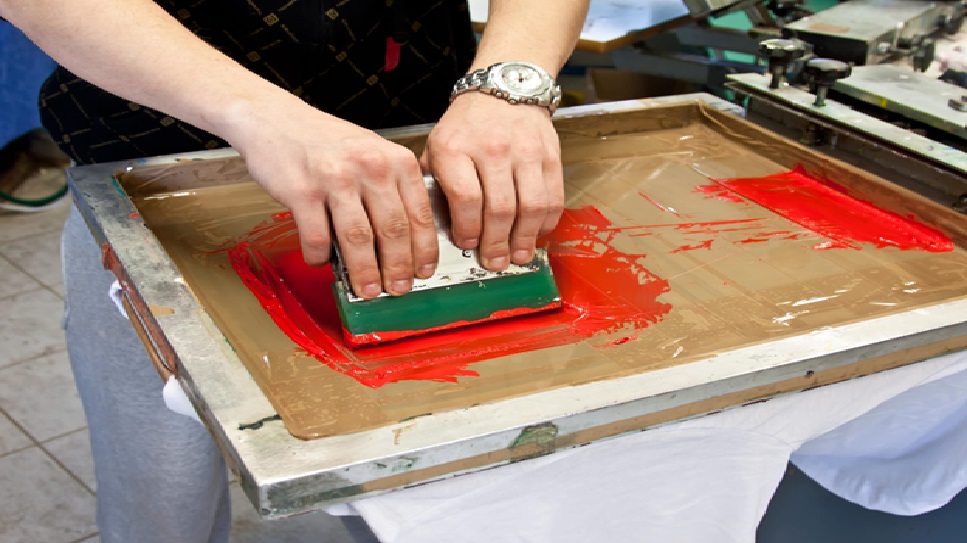When it comes to creating custom apparel, the possibilities are nearly endless. The design itself is only limited by creativity—whether it’s bold graphics, detailed illustrations, single-color prints, or vibrant multi-color artwork, the options are vast.
However, choosing the right printing method is just as important as the design. Various techniques are available for transferring artwork onto t-shirts, sweatshirts, and other apparel, each with its own advantages. Some of the most commonly used methods include:
- Direct-to-Garment Printing (DTG) – A specialized printer applies ink directly onto the fabric.
- Direct-to-Film Printing (DTF) – A design is printed onto a film, which is then transferred onto apparel using heat and pressure.
- Dye Sublimation – A process where dyes infuse into the fabric, creating long-lasting prints.
- Screen Printing – Ink is transferred onto fabric using a mesh screen and stencil.
Why Screen Printing Remains the Best Choice for Apparel
First, we do have to say, that we are a screen-printing company in St. Louis, so we are obviously biased when it comes to deciding which option for apparel printing is best. Having said that, we can have easily switched to sublimation, DTF, or DTG printing years ago. Those methods take significantly less time and work than screen printing, but they simply do not have the same quality.
Each has its own benefit and you can find countless articles comparing Screen-Printing vs Direct-to-Garment for t-shirt designs, so there are plenty of additional resources to help you understand the pros and cons of each method.
A Look at the History of Screen Printing
Screen printing has been around for nearly a thousand years, originating in China during the Song Dynasty in the 1100s. Early methods used paper stencils and mesh made from human hair to apply dyes and patterns onto silk garments. The technique later spread across Asia, gaining popularity in Japan.
18th Century: Expansion in Europe
Although European countries experimented with similar transfer techniques earlier, screen printing became more widely used in the 18th century, particularly in France, where it was applied to textiles and artwork.
19th Century: Introduction in the United States
Screen printing made its way to the U.S. and saw significant advancements, including the adoption of squeegees instead of brushes to apply ink. By the early 20th century, the process was revolutionized with the introduction of photoreactive stencils, making it more efficient and commercially viable.
1940s-1970s: The Artistic Revolution
The technique gained mainstream attention in the 1940s when artists formed organizations to promote screen printing as an artistic medium. By the 1960s, the method became iconic in the art world, with famous artists using it to create bold, colorful prints.
Screen Printing Today: A Timeless Technique
Despite technological advancements, screen printing remains one of the most reliable methods for custom apparel. Innovations in ink, machinery, and materials have improved the process without sacrificing quality. Unlike many printing methods that prioritize affordability at the expense of durability, modern screen printing enhances both longevity and vibrancy, making it the preferred choice for high-quality designs.
This printing technique continues to be widely used for its ability to produce bold, long-lasting prints. The versatility of screen printing allows for detailed designs on various types of fabric, ensuring that garments maintain their professional look even after multiple washes. Whether for fashion, marketing, or branding, screen printing remains a trusted option.
Durability and Longevity
One of the biggest advantages of screen printing is its exceptional durability. The ink used in this process bonds deeply with the fabric, creating prints that resist fading, peeling, and cracking over time. Unlike other methods that may wear down after repeated washing, screen-printed designs retain their original look and feel for years, making them a cost-effective choice for long-term use.
Additionally, screen printing is well-suited for bulk orders and high-use apparel, such as uniforms, team jerseys, and promotional items. Its ability to withstand frequent wear and washing ensures that businesses and organizations get maximum value from their investment in custom-printed clothing.
Sustainability in Screen Printing
As sustainability becomes a growing concern in the fashion and textile industry, screen printing continues to align with eco-friendly practices. Many inks used today are water-based, reducing the environmental impact compared to traditional solvent-based inks. This shift toward more sustainable materials makes screen printing a responsible choice for businesses and individuals seeking environmentally friendly solutions.
Beyond ink choices, screen printing also minimizes waste by allowing efficient production methods. Large-scale printing runs reduce material waste, while advancements in recycling and ink disposal practices help limit pollution. Choosing screen printing not only ensures high-quality results but also supports sustainability efforts in the apparel industry.
Bring Your Designs to Life with Screen Printing
For anyone looking to create custom apparel with a high-quality, time-tested method, screen printing remains the best option. It offers a perfect balance of durability, vibrant colors, and precision, making it ideal for personal use, business branding, or promotional merchandise. The ability to customize garments with long-lasting prints ensures that screen-printed apparel stands out from the competition.
Whether designing t-shirts, sweatshirts, or other apparel, screen printing provides a professional and polished look that withstands the test of time. By choosing this proven method, individuals and businesses alike can achieve eye-catching, durable designs that leave a lasting impression.




